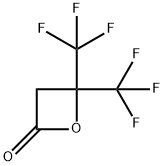Pivalolactone.
- CAS NO.:1955-45-9
- Empirical Formula: C5H8O2
- Molecular Weight: 100.12
- MDL number: MFCD01709494
- SAFETY DATA SHEET (SDS)
- Update Date: 2024-12-18 14:08:57

What is Pivalolactone.?
Chemical properties
colourless liquid
The Uses of Pivalolactone.
Carcinogenic agent. Shows mutagenicity
What are the applications of Application
Pivalolactone is a cyclobutanone mutagenic compound
Synthesis Reference(s)
Tetrahedron Letters, 10, p. 1047, 1969 DOI: 10.1017/S0009838800024678
General Description
Clear colorless liquid.
Air & Water Reactions
Pivalolactone. is unstable in water. Slowly hydrolyzes
Reactivity Profile
Pivalolactone. is an ester. Esters react with acids to liberate heat along with alcohols and acids. Strong oxidizing acids may cause a vigorous reaction that is sufficiently exothermic to ignite the reaction products. Heat is also generated by the interaction of esters with caustic solutions. Flammable hydrogen is generated by mixing esters with alkali metals and hydrides. Pivalolactone. is incompatible with alkanes.
Fire Hazard
Flash point data for Pivalolactone. are not available; however, Pivalolactone. is probably combustible.
Safety Profile
Poison by ingestion. Questionable carcinogen with experimental carcinogenic and tumorigenic data. Mutation data reported. When heated to decomposition it emits acrid smoke and irritating fumes.
Properties of Pivalolactone.
| Melting point: | -12.9°C |
| Boiling point: | 51°C@20mmHg. |
| Density | 0.9971 (rough estimate) |
| refractive index | 1.4043 (estimate) |
| solubility | soluble in Chloroform, Methanol |
| form | Colourless Solution |
| Stability: | Stable. Combustible. Incompatible with strong oxidizing agents. |
| EPA Substance Registry System | Pivalolactone (1955-45-9) |
Safety information for Pivalolactone.
Computed Descriptors for Pivalolactone.
New Products
Tert-butyl bis(2-chloroethyl)carbamate 4-Methylphenylacetic acid N-Boc-D-alaninol N-BOC-D/L-ALANINOL 3-Morpholino-1-(4-nitrophenyl)-5,6-dihydropyridin- 2(1H)-one Furan-2,5-Dicarboxylic Acid Tropic acid DIETHYL AMINOMALONATE HYDROCHLORIDE 1,1’-CARBONYLDIIMIDAZOLE R-2-BENZYLOXY PROPIONIC ACID 1,1’-CARBONYLDI (1,2-4 TRIAZOLE) N-METHYL INDAZOLE-3-CARBOXYLIC ACID (2-Hydroxyphenyl)acetonitrile 4-Bromopyrazole 5-BROMO-2CYANO PYRIDINE 5,6-Dimethoxyindanone 5-broMo-2-chloro-N-cyclopentylpyriMidin-4-aMine 2-(Cyanocyclohexyl)acetic acid 4-methoxy-3,5-dinitropyridine 2-aminopropyl benzoate hydrochloride 1-(4-(aminomethyl)benzyl)urea hydrochloride diethyl 2-(2-((tertbutoxycarbonyl)amino) ethyl)malonate tert-butyl 4- (ureidomethyl)benzylcarbamate Ethyl-2-chloro((4-methoxyphenyl)hydrazono)acetateRelated products of tetrahydrofuran






You may like
-
 2033-24-1 98%View Details
2033-24-1 98%View Details
2033-24-1 -
 1975-50-4 98%View Details
1975-50-4 98%View Details
1975-50-4 -
 2-HYDROXY BENZYL ALCOHOL 98%View Details
2-HYDROXY BENZYL ALCOHOL 98%View Details
90-01-7 -
 2-Chloro-1,3-Bis(Dimethylamino)Trimethinium Hexafluorophosphate 221615-75-4 98%View Details
2-Chloro-1,3-Bis(Dimethylamino)Trimethinium Hexafluorophosphate 221615-75-4 98%View Details
221615-75-4 -
 61397-56-6 CIS BROMO BENZOATE 98%View Details
61397-56-6 CIS BROMO BENZOATE 98%View Details
61397-56-6 -
 14714-50-2 (2-Hydroxyphenyl)acetonitrile 98+View Details
14714-50-2 (2-Hydroxyphenyl)acetonitrile 98+View Details
14714-50-2 -
 118753-70-1 98+View Details
118753-70-1 98+View Details
118753-70-1 -
 733039-20-8 5-broMo-2-chloro-N-cyclopentylpyriMidin-4-aMine 98+View Details
733039-20-8 5-broMo-2-chloro-N-cyclopentylpyriMidin-4-aMine 98+View Details
733039-20-8